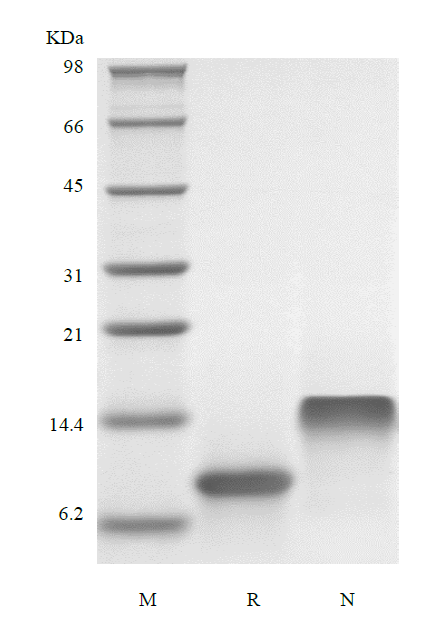- Synonyms
- Beta-R1, H174, IP-9, Small-inducible Cytokine B11
- Source
- Escherichia coli.
- Molecular Weight
- Approximately 8.3 kDa, a single non-glycosylated polypeptide chain containing 73 amino acids.
- AA Sequence
- FPMFKRGRCL CIGPGVKAVK VADIEKASIM YPSNNCDKIE VIITLKENKG QRCLNPKSKQ ARLIIKKVER KNF
- Purity
- > 97 % by SDS-PAGE and HPLC analyses.
- Biological Activity
- Fully biologically active when compared to standard. The biological activity determined by a chemotaxis bioassay using human IL-2 activated human T-lymphocytes is in a concentration range of 0.1-10 ng/ml.
- Physical Appearance
- Sterile Filtered White lyophilized (freeze-dried) powder.
- Formulation
- Lyophilized from a 0.2 µm filtered concentrated solution in 20 mM PB, pH 7.4, 100 mM NaCl.
- Endotoxin
- Less than 1 EU/µg of rHuI-TAC/CXCL11 as determined by LAL method.
- Reconstitution
- We recommend that this vial be briefly centrifuged prior to opening to bring the contents to the bottom. Reconstitute in sterile distilled water or aqueous buffer containing 0.1 % BSA to a concentration of 0.1-1.0 mg/mL. Stock solutions should be apportioned into working aliquots and stored at ≤ -20 °C. Further dilutions should be made in appropriate buffered solutions.
- Stability & Storage
- Use a manual defrost freezer and avoid repeated freeze-thaw cycles.
- 12 months from date of receipt, -20 to -70 °C as supplied.
- 1 month, 2 to 8 °C under sterile conditions after reconstitution.
- 3 months, -20 to -70 °C under sterile conditions after reconstitution.
- Usage
- This material is offered by Shanghai PrimeGene Bio-Tech for research, laboratory or further evaluation purposes. NOT FOR HUMAN USE.
- SDS-PAGE

- Reference
- 1. Tensen CP, Flier J, Rampersad SS, et al. 1999. Biochim Biophys Acta. 1446:167-72.
2. Cole KE, Strick CA, Paradis TJ, et al. 1998. J Exp Med. 187:2009-21.
3. Rani MR, Foster GR, Leung S, et al. 1996. J Biol Chem. 271:22878-84.
4. Tensen CP, Flier J, Van Der Raaij-Helmer EM, et al. 1999. J Invest Dermatol. 112:716-22.
- Background
- CXCL11 also known as I-TAC is belonging to the CXC chemokine family and shares 36 % and 37 % amino acid sequence homology with IP-10 and MIG, respectively. It is highly expressed in peripheral blood leukocytes, pancreas and liver. Expression of CXCL11 is strongly induced by IFN-γ and IFN-β, and weakly induced by IFN-α. This chemokine elicits its effects by binding to the cell surface chemokine receptor CXCR3, which with a higher affinity than do the other chemokines for this receptor, CXCL9 and CXCL10. Similar to CXCL10, CXCL11 has been shown to be a chemoattractant for IL-2-activated T-lymphocytes, but not for isolated T-cells, neutrophils or monocytes.







 COA申请
COA申请
